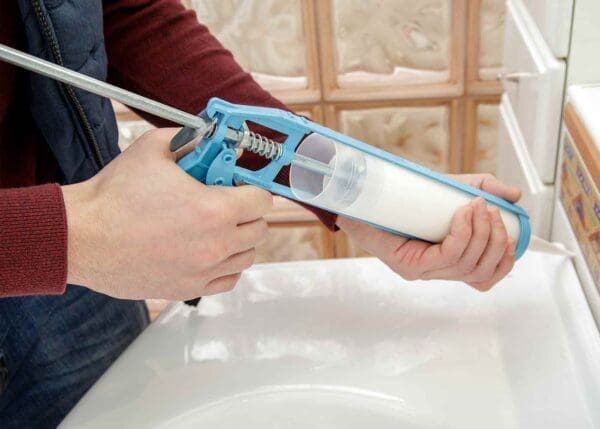01. Asbestos Use in Adhesives
Why Was Asbestos Used in Adhesives?
Asbestos fibers were a popular additive to construction adhesives because of their strength and heat resistance. These properties led manufacturers to put asbestos in adhesive products for decades.
Asbestos adhesives, bondings and sealants were used with a variety of construction materials. These products were often used to adhere insulation to pipes and boilers in homes, buildings and naval vessels.
Asbestos Adhesives History at a Glance
- Other Names: Black mastic, boiler caulking, bonding, construction mastics, cutback adhesives, glue, heavy-duty adhesives, sealants
- Years of Manufacture: Early 1900s – Present
- Military Use: Air Force, Army, Marines, Merchant Marines, Navy
- Places Used: Aircraft and airplanes, ceiling tiles, roofing materials, ships, vinyl sheet flooring, vinyl tiles
- Asbestos Use Banned: No
- Noteworthy Brands: American Olean Tile Company, Minnesota Mining and Manufacturing (3M), National Gypsum Company, Owens Corning/Fibreboard Corporation
02. List of Asbestos Adhesives
List of Asbestos Adhesives
In the past, a variety of adhesive products included asbestos as an ingredient. They were used as glues, sealants and waterproofing materials. These adhesive products may have contained up to 25% asbestos fibers.
Adhesive products that may contain asbestos include:
- Adhesive
- Black mastics
- Caulking
- Fibrous adhesive
- Joint compound
- Mastics
- Mortar
- Putty
- Sealer
- Spackling
- Tape
Many asbestos companies manufactured adhesive products. For years, these companies knew the health risks of asbestos but continued to use the mineral in adhesives and other asbestos products.
03. Adhesives & Asbestos Exposure
Who Is at Risk of Asbestos Exposure From Adhesives?
Workers in the construction, HVAC, shipbuilding and automobile industries used asbestos adhesives. Workers who manufactured or used these adhesives were at risk of occupational asbestos exposure.
Asbestos adhesives also pose an ongoing exposure risk to anyone who disturbs or removes them improperly. Construction projects, renovations or demolitions can release asbestos fibers into the air. Breathing in asbestos fibers can lead to serious illnesses including lung cancer and mesothelioma.
Homeowners may also encounter asbestos exposure risks if they disturb asbestos adhesives. In some cases, asbestos adhesive products may also deteriorate over time, releasing fibers into the air.
04. Asbestos Lawsuits
Asbestos Lawsuits, Settlements & Other Compensation
Individuals who developed illnesses after using asbestos adhesives may seek financial compensation. Some may choose to file a mesothelioma lawsuit. Other potential compensation options include:
Many asbestos-exposed individuals have filed successful lawsuits. A mesothelioma lawyer can help determine which legal options are best for people harmed by asbestos.
Compensation Following Exposure to Asbestos Joint Compound
People exposed to asbestos construction adhesives have received compensation through lawsuits and settlements. For example, a former construction company owner filed a successful lawsuit against several companies after he was diagnosed with mesothelioma in 2011.
The man owned his own construction business from 1964 to 1994. He often visited residential construction sites when workers were sanding drywall joints. As a result, he frequently encountered asbestos dust released from the joint compound.
After his mesothelioma diagnosis, the man and his wife filed an asbestos lawsuit. It named several companies that made asbestos-containing joint compounds used at his jobsites:
- Georgia-Pacific Corporation
- Hamilton Materials, Inc.
- Kaiser Gypsum Company, Inc.
- Kelly-Moore Paints
A jury awarded the couple $30 million in compensatory damages and $18 million in punitive damages. This jury award may have covered certain expenses related to diagnosis and treatment of mesothelioma.
In some cases, patients may be able to secure a mesothelioma settlement instead of a jury award. Like a jury award, the settlement may cover treatment and other related costs. Individuals exposed to asbestos adhesives may benefit from speaking with a mesothelioma law firm. The law firm can help weigh the benefits of potential compensation options.
05. Asbestos Adhesive Removal
Safely Removing Asbestos Adhesives
Asbestos removal professionals should handle any removal of asbestos adhesives or mastics. Though the fibers may be “locked in” by adhesive, removing or breaking up the adhesive could release them. Professionals have the training and equipment to do this safely.
According to experts, removing and disposing of asbestos adhesives is an involved process. Some adhesives can be removed by wet-scraping. This method requires spraying the asbestos adhesive with a mixture of water and detergent.
This fluid needs to cover the entire adhesive surface throughout removal. With the water and detergent covering the area, the adhesive can be scraped off with a metal scraper. When the adhesive is scraped away, the area must be wet-vacuumed with a HEPA vacuum.
Once removed, asbestos adhesive must be disposed of properly:
- Removed adhesive must be placed in a leak-tight container.
- The container must be labeled clearly as hazardous, asbestos-contaminated material.
- The container must go to a landfill or disposal facility approved to handle asbestos waste.
In general, facilities charge a fee for disposal of asbestos waste. This fee may depend on the volume of waste. With this many steps, risks and costs, asbestos adhesive removal is best left to professionals.



